Carotenoid Market Size
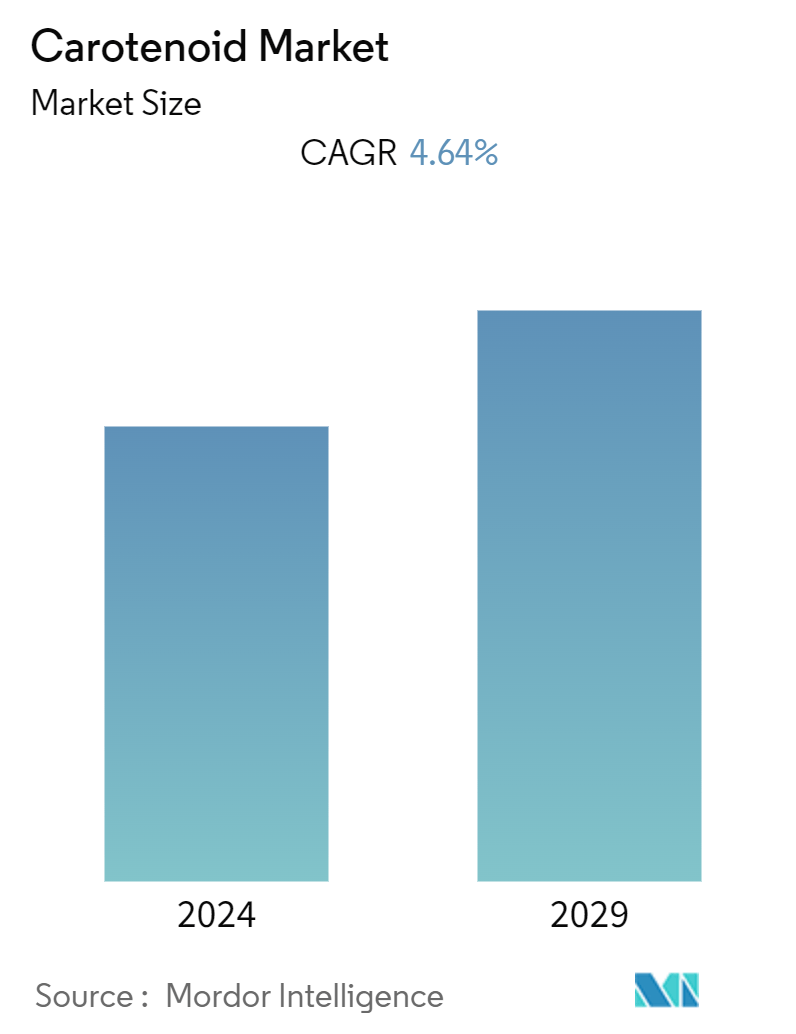
| Study Period | 2019 - 2029 |
| Base Year For Estimation | 2023 |
| CAGR (2024 - 2029) | 4.64 % |
| Fastest Growing Market | Asia |
| Largest Market | Europe |
| Market Concentration | High |
Major Players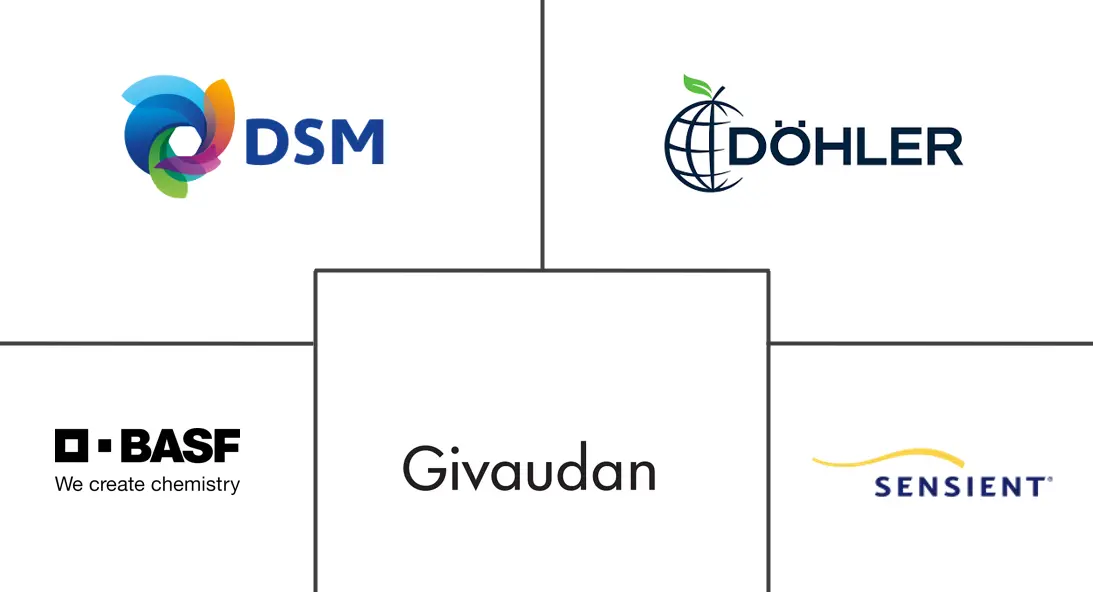
*Disclaimer: Major Players sorted in no particular order |
Carotenoid Market Analysis
The Carotenoid Market is expected to register a CAGR of 4.64% during the forecast period.
The market is primarily driven by the increasing demand for carotenoids in different food and beverage applications. The shift in consumer preferences toward natural and organic products due to the rising health consciousness is another primary factor behind significant market growth. Carotenoids are used in bakery, confectionery, soft drinks, and beverages as food colorants.
In the cosmetic industry, carotenoids are used for their anti-aging and skin-protective properties. Products containing carotenoids are marketed for their ability to provide a healthy skin glow and protect against UV damage. Prominent market players are launching new products to uphold their position in the market. For instance, in March 2023, Symrise Company introduced a new ingredient named Diana food, which is bioactive, developed using carotenoids, and compatible with skincare products that target anti-aging, skin brightening, and skin conditioning.
The dietary supplements market is expanding rapidly, with carotenoids being key ingredients due to their health benefits. Supplements containing carotenoids are popular for supporting vision, skin health, and overall wellness. Carotenoids, such as carotene, zeaxanthin, lutein, and pro-vitamin A, are naturally found in the human eye's retina. Therefore, using carotenoids in over-the-counter (OTC) dietary supplements aids in the prevention of several diseases, including macular degeneration, heart disease, and cancer. In addition, the need for carotenoids increases with the rise of preventive healthcare.
Carotenoid Market Trends
Increasing Demand for Dietary Supplements is Expected to Boost the Market's Growth
Carotenoids are widely used in health and wellness products and dietary supplements because of their antioxidant properties, offering a range of health benefits. Carotenoids decrease the risk of certain diseases, particularly cancers and eye diseases. They also aid in strengthening the immune system by supporting the production of specific kinds of white blood cells. Oral carotenoid supplements help cardiovascular functions by protecting arterial walls and managing healthy blood cholesterol levels. Therefore, increasing awareness of these health benefits and rising health consciousness among consumers is driving the market's growth.
Moreover, with the increasing consumer spending on skincare products for better skin health, beauty product manufacturers are formulating products using carotenoids due to their functional benefits. For instance, in December 2023, Sun Chemical expanded its SunPURO Naturals product line to meet the beauty industry’s growing need for responsibly sourced natural colorants in cosmetic and personal care formulations. The new launch products include SunPURO® Natural Carotene O N70-2317 and SunPURO® Natural Carotene BTO N70-2527. Such innovations are expected to influence the market positively in the coming years.
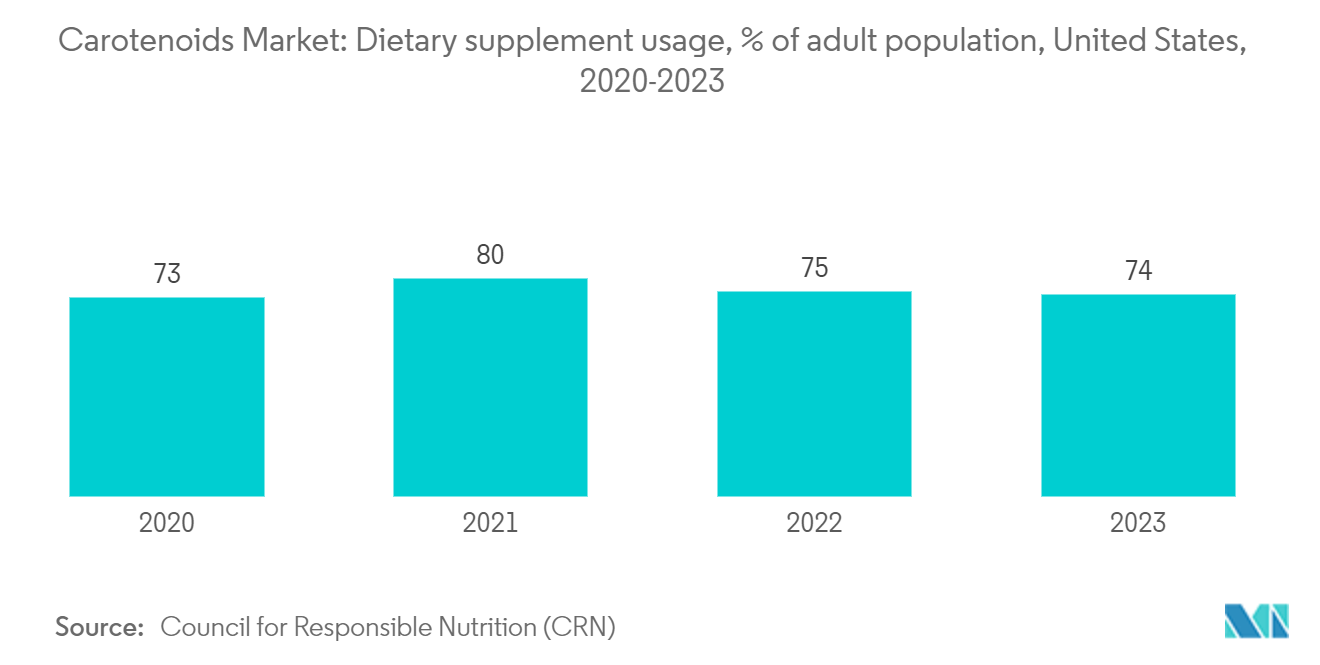
Europe is Expected to Dominate the Market
Europe is the largest market for carotenoids, primarily due to the rise of the health-conscious population. The biological properties of carotenoids allow for a wide range of commercial applications. The main applications of carotenoids are in dietary supplements, fortified foods, food coloring, animal feed, pharmaceuticals, and cosmetics.
Consumers are increasingly scrutinizing ingredient lists and are increasingly inclined toward clean-label products. Carotenoids, natural colorants sourced from fruits and vegetables, resonate with this preference and are used by food and beverage manufacturers as alternatives to synthetic colors and additives in soft drinks. For instance, according to the Union of European Beverages Associations (UNESDA), the annual consumption of soft drinks in the European Union (EU) was estimated to be 51,884 million liters in 2022, which increased from 48,662.8 million liters in 2021.
Additionally, the ongoing exploration of novel ingredients and formulations propels the adoption of carotenoids in the pharmaceutical industry. As research focuses on identifying effective natural ingredients, carotenoids emerge as a compelling option. New ways to produce carotenoids from different sources and increasing research and developments of carotenoids are expected to fuel the market's growth. According to the European Commission, Spanish researchers have developed a system to produce lutein from the green algae murieollopsis for its pharmaceutical use. The researchers also claimed that this lutein can protect consumers from diseases, including cataracts and macular degeneration.
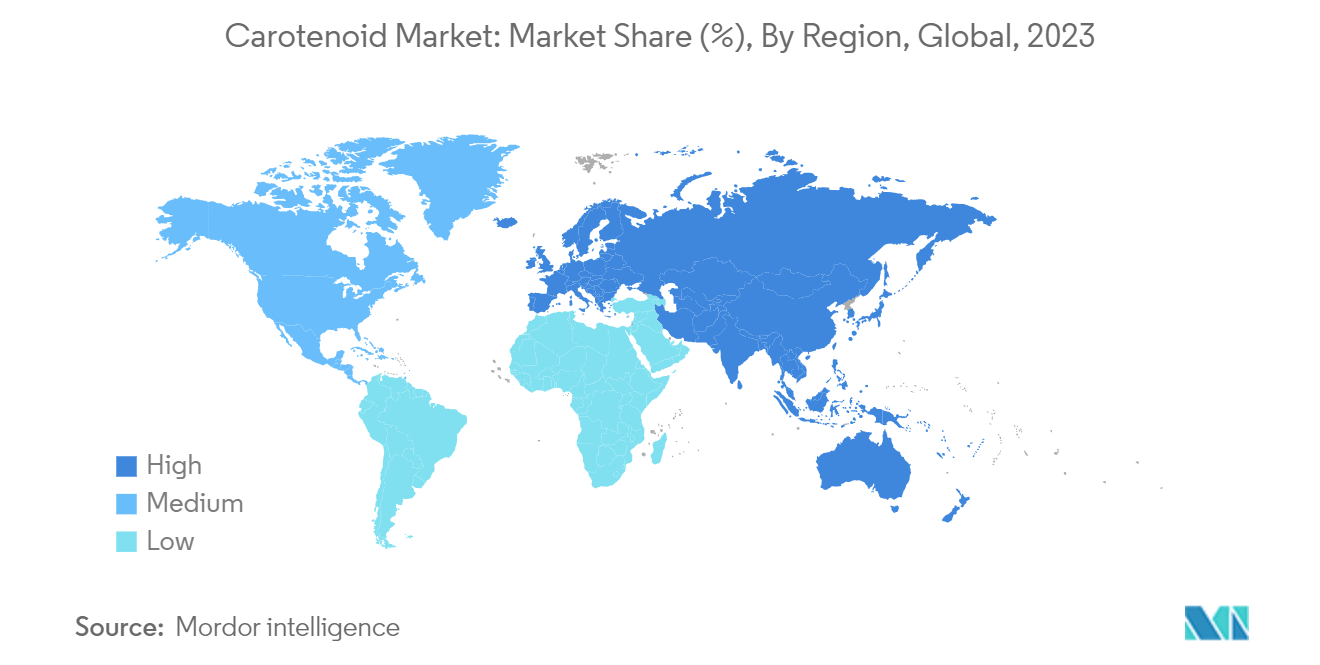
Carotenoid Industry Overview
The beta-carotene market is concentrated, with the major players occupying the largest share of the market. Some key players in the market are BASF, Koninklijke DSM NV, Givaudan SA, Döhler Group SE, and Sensient Technologies Co. The major players in the market are indulging in strategies like product launches, mergers and acquisitions, and expansions to establish a solid consumer base. In addition, companies are increasing their investments in research and development (R&D) and are expanding their distribution channels to maintain their position in the market. Moreover, companies are launching campaigns to increase consumer awareness. For instance, in December 2023, the ingredient supplier OmniActive launched the "Lutein for Every Age" initiative. This campaign aims to raise awareness about the importance of lutein and zeaxanthin intake to help support eye, cognitive, and general health.
Carotenoid Market Leaders
-
Koninklijke DSM NV
-
Givaudan SA
-
Döhler Group SE
-
Sensient technologies Co.
-
BASF SE
*Disclaimer: Major Players sorted in no particular order
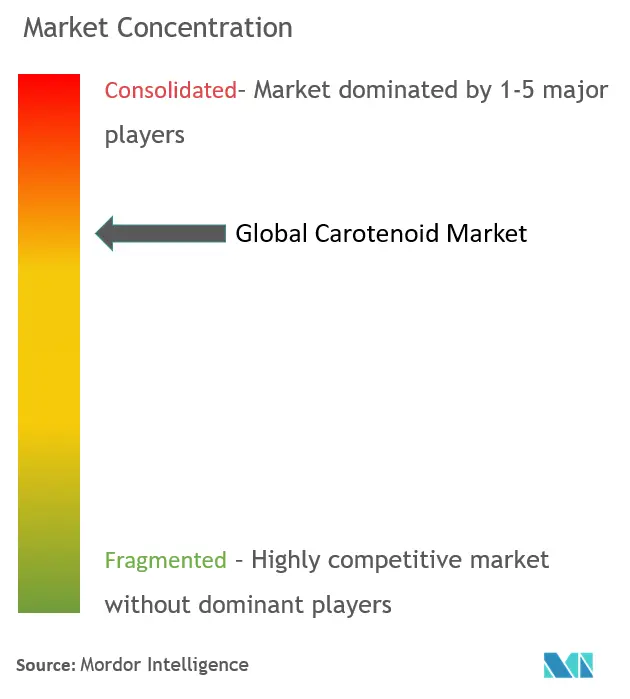
Carotenoid Market News
May 2024: Cepham, a supplier specializing in Ayurvedic ingredients, launched a new eye health formulation called Luteye. This formulation combines macular carotenoids lutein and zeaxanthin with extra virgin olive oil enriched with oleocanthal. The purpose of Luteye is to target the effects of aging on eye health.
April 2024: Divi’s Nutraceuticals launched innovative astaxanthin solutions at Vitafoods Europe 2024. The company launched AstaBead, a highly concentrated beadlet of sustainable natural astaxanthin. AstaBead beadlets claim to contain 5% astaxanthin. The product can be used in smaller tablets and hard-shell capsules and has applications in nutritional bars and fortified powder drinks.
March 2024: BASF presented its innovative solution called Beta-Carotene 20% GFP, free of gelatin with best-in-class stability, at the Food Ingredients China (FIC) 2024 trade show at the Shanghai National Exhibition and Convention Center. The company showcased its latest advancements in nutritional solutions.
Carotenoids Market Report - Table of Contents
1. INTRODUCTION
- 1.1 Study Assumptions and Market Definition
- 1.2 Scope of the Study
2. RESEARCH METHODOLOGY
3. EXECUTIVE SUMMARY
4. MARKET DYNAMICS
-
4.1 Market Drivers
- 4.1.1 Growing Awareness of Functional Benefits of Carotenoids
- 4.1.2 Rising Consumption of Health and Wellness Products Containing Carotenoids
-
4.2 Market Restraints
- 4.2.1 High Processing Cost and Low Yield of Natural Food Colors
-
4.3 Porter's Five Forces Analysis
- 4.3.1 Threat of New Entrants
- 4.3.2 Bargaining Power of Buyers/Consumers
- 4.3.3 Bargaining Power of Suppliers
- 4.3.4 Threat of Substitute Products
- 4.3.5 Intensity of Competitive Rivalry
5. MARKET SEGMENTATION
-
5.1 By Type
- 5.1.1 Annatto
- 5.1.2 Astaxanthin
- 5.1.3 Beta Carotene
- 5.1.4 Canthaxanthin
- 5.1.5 Lutein
- 5.1.6 Lycopene
- 5.1.7 Zeaxanthin
- 5.1.8 Other Types
-
5.2 By Source
- 5.2.1 Natural
- 5.2.2 Synthetic
-
5.3 By Application
- 5.3.1 Animal Feed
- 5.3.2 Food and Beverages
- 5.3.3 Dietary Supplements
- 5.3.4 Cosmetics
- 5.3.5 Pharmaceuticals
-
5.4 Geography
- 5.4.1 North America
- 5.4.1.1 United States
- 5.4.1.2 Canada
- 5.4.1.3 Mexico
- 5.4.1.4 Rest of North America
- 5.4.2 Europe
- 5.4.2.1 United Kingdom
- 5.4.2.2 Germany
- 5.4.2.3 France
- 5.4.2.4 Russia
- 5.4.2.5 Italy
- 5.4.2.6 Spain
- 5.4.2.7 Rest of Europe
- 5.4.3 Asia-Pacific
- 5.4.3.1 India
- 5.4.3.2 China
- 5.4.3.3 Japan
- 5.4.3.4 Australia
- 5.4.3.5 Rest of Asia-Pacific
- 5.4.4 South America
- 5.4.4.1 Brazil
- 5.4.4.2 Argentina
- 5.4.4.3 Rest of South America
- 5.4.5 Middle East and Africa
- 5.4.5.1 South Africa
- 5.4.5.2 Saudi Arabia
- 5.4.5.3 Rest of Middle East and Africa
6. COMPETITIVE LANDSCAPE
- 6.1 Most Adopted Strategies
- 6.2 Market Share Analysis
-
6.3 Company Profiles
- 6.3.1 Divi's Laboratories Limited
- 6.3.2 Givaudan SA
- 6.3.3 Koninklijke DSM NV
- 6.3.4 Sensient Technologies Co.
- 6.3.5 Döhler Group SE
- 6.3.6 The Solabia Group
- 6.3.7 Allied Biotech Corp.
- 6.3.8 EID - Parry (India) Limited
- 6.3.9 Cyanotech Corporation
- 6.3.10 BASF SE
- *List Not Exhaustive
7. MARKET OPPORTUNITIES AND FUTURE TRENDS
** Subject To AvailablityCarotenoid Industry Segmentation
Carotenoids are pigments found naturally in plants, algae, and photosynthetic bacteria. These pigments produce bright yellow, red, and orange colors in plants, vegetables, and fruits.
The global carotenoid market is segmented by type, source, application, and geography. By type, the market is segmented into annatto, astaxanthin, beta-carotene, canthaxanthin, lutein, lycopene, zeaxanthin, and other types. By source, the market is segmented into natural and synthetic. By application, the market is segmented into animal feed, food and beverages, dietary supplements, cosmetics, and pharmaceuticals. By geography, the market is segmented into North America, Europe, Asia-Pacific, South America, and Middle East and Africa. For each segment, the market sizing and forecasts were made based on the value in USD.
| By Type | Annatto | |
| Astaxanthin | ||
| Beta Carotene | ||
| Canthaxanthin | ||
| Lutein | ||
| Lycopene | ||
| Zeaxanthin | ||
| Other Types | ||
| By Source | Natural | |
| Synthetic | ||
| By Application | Animal Feed | |
| Food and Beverages | ||
| Dietary Supplements | ||
| Cosmetics | ||
| Pharmaceuticals | ||
| Geography | North America | United States |
| Canada | ||
| Mexico | ||
| Rest of North America | ||
| Geography | Europe | United Kingdom |
| Germany | ||
| France | ||
| Russia | ||
| Italy | ||
| Spain | ||
| Rest of Europe | ||
| Geography | Asia-Pacific | India |
| China | ||
| Japan | ||
| Australia | ||
| Rest of Asia-Pacific | ||
| Geography | South America | Brazil |
| Argentina | ||
| Rest of South America | ||
| Geography | Middle East and Africa | South Africa |
| Saudi Arabia | ||
| Rest of Middle East and Africa |
Carotenoids Market Research FAQs
What is the current Carotenoid Market size?
The Carotenoid Market is projected to register a CAGR of 4.64% during the forecast period (2024-2029)
Who are the key players in Carotenoid Market?
Koninklijke DSM NV, Givaudan SA, Döhler Group SE, Sensient technologies Co. and BASF SE are the major companies operating in the Carotenoid Market.
Which is the fastest growing region in Carotenoid Market?
Asia is estimated to grow at the highest CAGR over the forecast period (2024-2029).
Which region has the biggest share in Carotenoid Market?
In 2024, the Europe accounts for the largest market share in Carotenoid Market.
What years does this Carotenoid Market cover?
The report covers the Carotenoid Market historical market size for years: 2019, 2020, 2021, 2022 and 2023. The report also forecasts the Carotenoid Market size for years: 2024, 2025, 2026, 2027, 2028 and 2029.
Carotenoid Industry Report
Statistics for the 2024 Carotenoid market share, size and revenue growth rate, created by Mordor Intelligence™ Industry Reports. Carotenoid analysis includes a market forecast outlook to 2029 and historical overview. Get a sample of this industry analysis as a free report PDF download.



